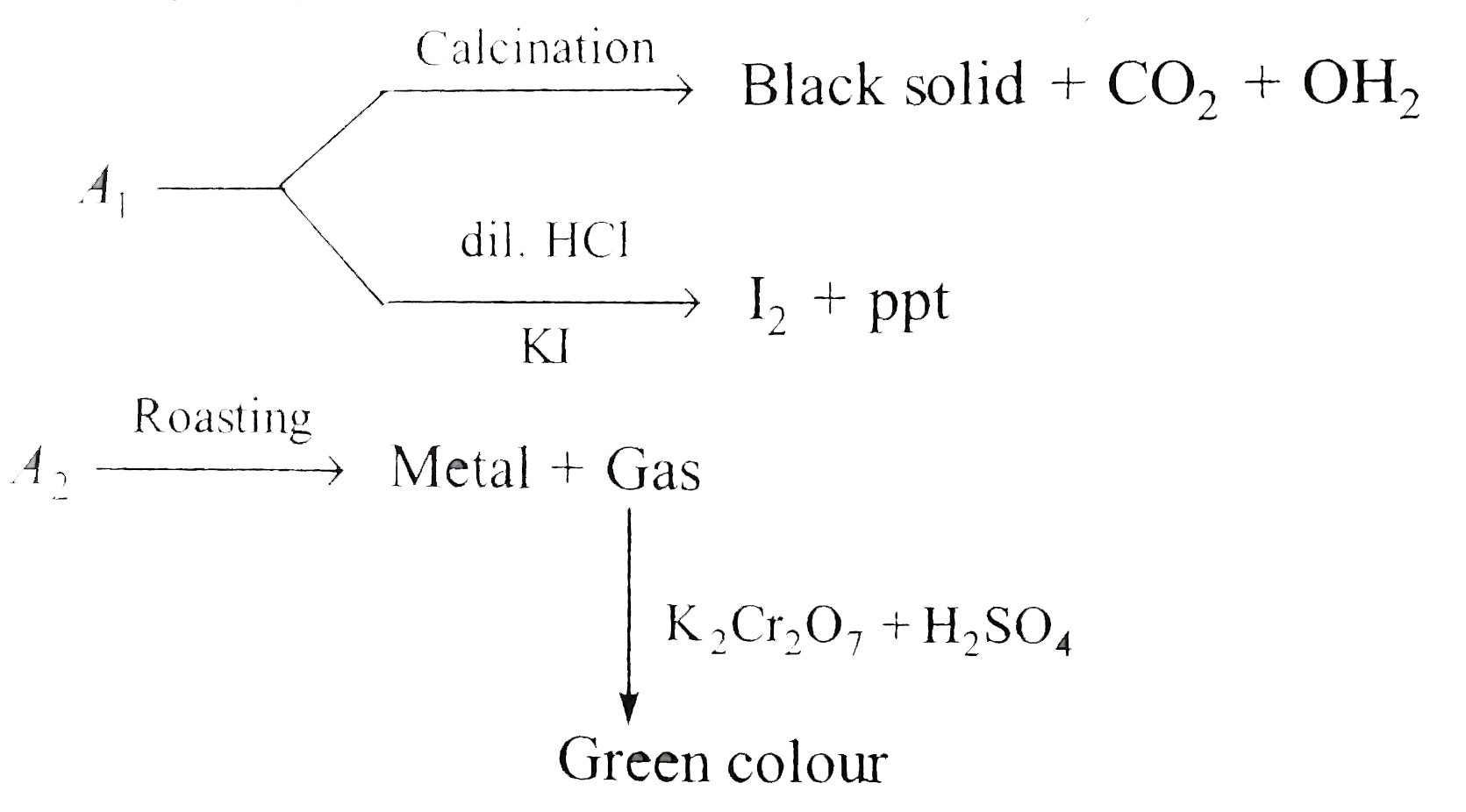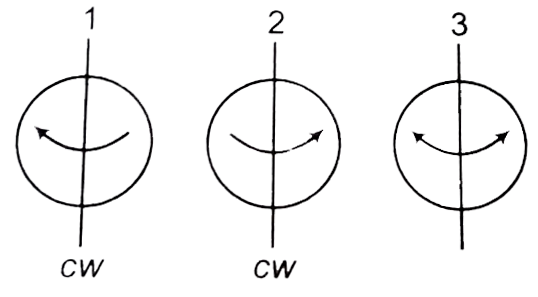A mixture consists of two metal oxides A (green) and B (white). Mixture was dissolved in 20mL2MNaOH solution contraining some H2O2 to give a clear yellow solution leaving no residue. The above solution was separated into two parts. One part was acidified with acetic acid and then treated with (CH3COO)2Pb solution to give an yellow precipitate (C). C dissolves in dilute nitric acid forming a clear orange solution. Other part of solution was acidified with 2.0MHCl and the 2MNH3 was added till the solution became alkaline and finally boiled. A white gelatinous precipitate (D) was obtained. D was then dissolved in dilute HCl and 6.0M ammonium acetate was added. The solutions was finally treated with a few drops of alumiun reagent and made basic by adding ammonium carbonate. A red precipitate was obtained. Answer the following three questions based on the above information.
Compounds A and B are respectively
Cr2O3 and Fe2O3
PbO and Al2O3
Cr2O3 and Al2O3
Fe2O3 and Al2O3
The correct Answer is:C
Topper's Solved these Questions
- QUALITATIVE ANALYSISBook:IIT-JEE PREVIOUS YEAR (CHEMISTRY)Chapter:QUALITATIVE ANALYSISExercise:Assertion and Reason
Explore 2 Videos
- QUALITATIVE ANALYSISBook:IIT-JEE PREVIOUS YEAR (CHEMISTRY)Chapter:QUALITATIVE ANALYSISExercise:Subjective Questions
Explore 27 Videos
- PERIODIC CLASSIFICATION AND PERIODIC PROPERTIESBook:IIT-JEE PREVIOUS YEAR (CHEMISTRY)Chapter:PERIODIC CLASSIFICATION AND PERIODIC PROPERTIESExercise:COMPREHENSION_TYPE
Explore 3 Videos
- S BLOCK ELEMENTSBook:IIT-JEE PREVIOUS YEAR (CHEMISTRY)Chapter:S BLOCK ELEMENTSExercise:True/False
Explore 1 Video
Similar Questions
Assertion Cations of both Cu(II) group and Fe(III) group are precipitated by passing H2S gas but former in dilute acidic medium while later in dilute alkaline medium.
Reason Sulphides of Cu(II) group cations have lower solubility than that of Fe(III) group cations.
View SolutionA1 and A2 are two ores of metal M. A1 on calcination gives black precipitate, CO2 and water.

Identify A1 and A2.
View SolutionLet's consider a hypothetical planet pseudo Earth which is similar to our earth in several aspects. The similarities are
On pseudo earth:
(i) There are same number of elements as on our earth and they are known by the same name.
(ii) Pauli's exclusion principal, Hund's Rule and Aufbau principle are known to the people of pseudo earth in the same manner as we know on our earth.
(iii) They classify elements as representative, transition and inner- transition elements in the same manner as we classify on our earth.
However, there is one basic difference in understanding the electrons, spin on these two earths. On our earth the electron can have only two spin directions. clock wise (1) and anti-clockwise (2), while on pseudo earth there is an additional possible value of spin quantum number called neutral spin (3) in which electron is believed to be fluctuating harmonically between clockwise and anti-clockwise directions, about its axis. Answer the following three question based on the above information.

The first noble gas on pseudo earth would be
View SolutionMgCl2.6H2O on heating gives anhydrous MgCl2
View SolutionAlkanline earth metal nitrate (A) on heating decompose, leaving a solid residue (B) which goes into solution with dilute HCI. The solution of (B) gives a white precipitate (C) is dissolved in dilute HCl and the solution is treated with potassium chromae to get yellow precipitate (D). The solution (B) with dilute H2SO4 also gives a white precipitate (E) insoluble in diute HCl and nitric acid. the precipitate (E) is a part of a white pigment lithopone.
The compound (E) is
View SolutionAlkanline earth metal nitrate (A) on heating decompose, leaving a solid residue (B) which goes into solution with dilute HCI. The solution of (B) gives a white precipitate (C) is dissolved in dilute HCl and the solution is treated with potassium chromae to get yellow precipitate (D). The solution (B) with dilute H2SO4 also gives a white precipitate (E) insoluble in diute HCl and nitric acid. the precipitate (E) is a part of a white pigment lithopone.
The yellow precipitate (D) is
View SolutionAlkanline earth metal nitrate (A) on heating decompose, leaving a solid residue (B) which goes into solution with dilute HCI . The solution of (B) gives a white precipitate (C ) is dissolved in dilute HCl and the solution is treated with potassium chromae to get yellow precipitate (D) . The solution (B) with dilute H_(2)SO_(4) also gives a white precipitate (E) insoluble in diute HCl and nitric acid. the precipitate (E) is a part of a white pigment lithopone. The metal nitrate (A) is
View SolutionAlkanline earth metal nitrate (A) on heating decompose, leaving a solid residue (B) which goes into solution with dilute HCI . The solution of (B) gives a white precipitate (C ) is dissolved in dilute HCl and the solution is treated with potassium chromae to get yellow precipitate (D) . The solution (B) with dilute H_(2)SO_(4) also gives a white precipitate (E) insoluble in diute HCl and nitric acid. the precipitate (E) is a part of a white pigment lithopone. The solid residue (B) is
View SolutionA mixture consists of two metal oxides A (green) and B (white). Mixture was dissolved in 20mL2MNaOH solution contraining some H2O2 to give a clear yellow solution leaving no residue. The above solution was separated into two parts. One part was acidified with acetic acid and then treated with (CH3COO)2Pb solution to give an yellow precipitate (C). C dissolves in dilute nitric acid forming a clear orange solution. Other part of solution was acidified with 2.0MHCl and the 2MNH3 was added till the solution became alkaline and finally boiled. A white gelatinous precipitate (D) was obtained. D was then dissolved in dilute HCl and 6.0M ammonium acetate was added. The solutions was finally treated with a few drops of alumiun reagent and made basic by adding ammonium carbonate. A red precipitate was obtained. Answer the following three questions based on the above information.
Compound C is most likely
View SolutionA mixture consists of two metal oxides A (green) and B (white). Mixture was dissolved in 20 mL 2M NaOH solution contraining some H_(2)O_(2) to give a clear yellow solution leaving no residue. The above solution was separated into two parts. One part was acidified with acetic acid and then treated with (CH_(3)COO)_(2)Pb solution to give an yellow precipitate (C). C dissolves in dilute nitric acid forming a clear orange solution. Other part of solution was acidified with 2.0 M HCl and the 2M NH_(3) was added till the solution became alkaline and finally boiled. A white gelatinous precipitate (D) was obtained. D was then dissolved in dilute HCl and 6.0 M ammonium acetate was added. The solutions was finally treated with a few drops of alumiun reagent and made basic by adding ammonium carbonate. A red precipitate was obtained. Answer the following three questions based on the above information. Compound D is most likely
View SolutionA metal salt solution gives a yellow precipitate with silver nitrate.The precipitate dissolves in dilute nitric acid as well as in dilute ammonia solution.The solution contains :
View SolutionA metal salt solution gives a yellow precipitate with silver nitrate. The precipitate dissolves in dilute nitric acid as well as in ammonium hydroxide. The solution contains
View SolutionMetal nitrate (A) on heating decomposes, leaving a solid residue (B) which goes into solution with dilute HCI. The solution of (B) gives a white precipitate with ammonium carbonate solution. The precipitate (C) is dissolved in dilute HCI and the solution is treated with potassium chromate to get yellow precipitate (D). The solution (B) with dilute H_(2)SO_(4) also gives a white precipitate (E) insoluble in dilute HCl and nitric acid. The precipitate (E) is a part of a white pigment lithopone. QThe compound (E) is:
View SolutionAlkanline earth metal nitrate (A) on heating decompose, leaving a solid residue (B) which goes into solution with dilute HCI. The solution of (B) gives a white precipitate (C) is dissolved in dilute HCl and the solution is treated with potassium chromate to get yellow precipitate (D). The solution (B) with dilute H2SO4 also gives a white precipitate (E) insoluble in diute HCl and nitric acid. the precipitate (E) is a part of a white pigment lithopone.
The yellow precipitate (D) is
View SolutionAlkanline earth metal nitrate (A) on heating decompose, leaving a solid residue (B) which goes into solution with dilute HCI. The solution of (B) gives a white precipitate (C) is dissolved in dilute HCl and the solution is treated with potassium chromate to get yellow precipitate (D). The solution (B) with dilute H2SO4 also gives a white precipitate (E) insoluble in diute HCl and nitric acid. the precipitate (E) is a part of a white pigment lithopone.
The metal nitrate (A) is
View Solution
